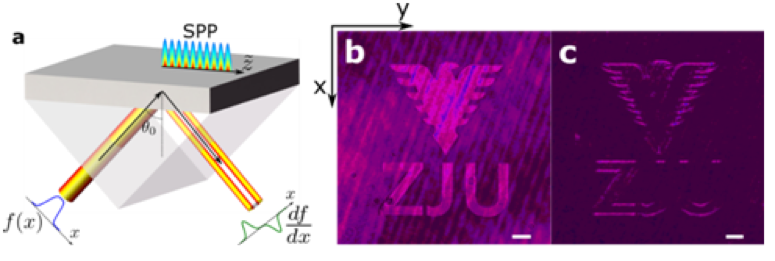Editor: Becky Time: 2018-03-19 Number of visits: 248
The research of Prof. Zhichao Ruan’s group from Department of Physics, Zhejiang University, Spatial differentiator: all-optical analog computing in subwavelength scale, has been selected as “2017’s China top ten breakthroughs in optics -- applications”. Ten fundamental researches and ten application researches, which stand for the most important breakthroughs in optical field in China, are annually awarded among over a hundred of candidates from many renowned universities and research institutes, such as Peking University, Tsinghua University, Shanghai Jiao Tong University, Chinese Academy of Sciences, etc.
Traditionally, optical analog computing in the spatial domain requires a bulky system of lenses and filters. Over the past few years, there have been significant efforts seeking to miniaturize such optical systems down to wavelength or even subwavelength scale. However, since all reported proposals are with complex structures, it is extremely challenging to fabricate them precisely and none of these structures have been demonstrated experimentally yet.
Prof. Ruan’s team members, cooperating with Prof. Min Qiu and Prof. Hui Ye from College of Optical Engineering and Prof. Shanhui Fan from Stanford University, have made new progress in analog optical computing. For the first time, the research team has experimentally demonstrated spatial differentiation with the plasmonic device and further exploited it in image processing for edge detection. The precision of the differentiation operation is about 94% and the resolution of the edge detection reaches 7 μm. The temporal bandwidth is as wide as 3 THz. The differentiator adopts the Kretschmann prism configuration and only requires 50nm-thick single silver layer, which is the only subwavelength optical analog device so far.

Such a method offers a brand-new approach for optical information processing. Particularly, the research team demonstrated substantial application to detect the edges for either amplitude or phase sharp change in the incident field, which is a vital step in object detection, feature classification and data compression. With standard thin-film deposition technology, the plasmonic differentiator can be fabricated in large scale. Therefore, such an ultrafast optical computing scheme with sufficient space-bandwidth product is capable of processing an entire image on a single shot, which is critically important for high-throughput real-time image processing and might be applied in artificial intelligence, such as optical neural network and ultrafast pattern identification.
This work has been published in Nature Communication in May 2017 titled Plasmonic computing of spatial differentiation [8, 15391 (2017)] (https://www.nature.com/articles/ncomms15391).

Add: No. 8 Hainayuan Building, Zijingang Campus, Zhejiang University, 866 Yuhangtang Rd, Hangzhou, 310027, P.R. China
Tel: +86-571-87953325
Fax: +86-571-87951895
Email: yongyi@zju.edu.cn